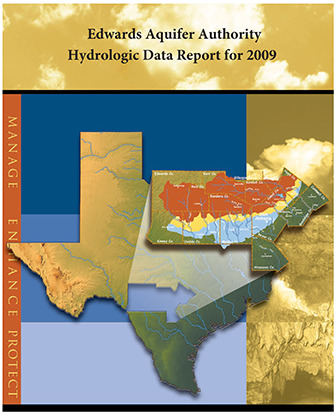Edwards Aquifer Authority Hydrologic Data Report for 2009

| Author | Hamilton M, Johnson S, Esquilin R, Burgoon C, Luevano G, Gregory D, Mireles J, Gloyd R and Schindel GM |
| Year | 2010 |
| Description | Annual report for 2009 on recharge, discharge, water levels and water quality in the Edwards Aquifer San Antonio Region |
| Report Number | 10-02 |
| Publisher | Edwards Aquifer Authority |
| Location | Edwards Aquifer - San Antonio Area |
| Cover | View Download |
| File | View Download |
| Summary |
|
This report presents results of the Authority’s Edwards Aquifer Data Collection Program for calendar year 2009…. Water levels at the Bexar County (J-17) index well trended downward from January through early September, when rains began and water levels began to rise. By late October, water levels at J-17 had risen to the historical average. Water levels remained above or close to the historical average for the remainder of the year. Other wells in the region exhibited similar behavior…. Precipitation in the Edwards Aquifer region was below the mean in 2009, with the exception of San Antonio, where the mean was exceeded by 0.38 inches. Although rainfall amounts improved in 2009 over calendar year 2008, regionally they were much lower in the west than in the east. …Total estimated recharge to the Edwards Aquifer was significantly below median … Calendar year 2009 recharge was lower than 2008 recharge by 2,000 acre-feet. …In calendar year 2009, groundwater discharge from the Edwards Aquifer through wells and springs totaled 683,765 acre-feet. This amount is below the median total discharge of 766,600 acre-feet for the period of record (1934–2009). … For well-water samples collected in 2009, strontium was detected at one location in close proximity to the saline zone above the 15,000-μg/L PCL. Other metals detected include iron at two locations above the secondary standard and manganese at one location above the secondary standard. Surface and spring water sample analyses did not indicate the presence of any regulated metals above a regulatory limit. … Seven of 74 wells tested positive for fecal coliform, and ten of 74 wells sampled tested positive for fecal streptococcus. …Of the 54 spring water samples, 24 were positive for fecal coliform, and 29 for fecal streptococcus. In samples from wells, streams, and springs in the Edwards Aquifer region, nitrate-nitrite as nitrogen concentrations in 2009 ranged from below the laboratory reporting limit of 0.015 to 6.03 mg/L. …The compounds chloroform, chloromethane, and toluene were detected below regulatory limits in wells in Medina, Bexar, and Hays counties. VOCs were not detected in the spring or in surface water samples collected for VOC analyses. …No SVOCs were detected.… The pesticide compound pentachlorophenol was detected at San Geronimo Creek at 0.25 μg/L. Edwards Aquifer water is generally of such high quality that it normally requires only chlorination to meet public drinking-water standards. However, detection of nitrates and organic compounds in the aquifer is a concern, and the Authority will continue to monitor for these compounds to determine possible sources and trends….Confirmed detections of anthropogenic compounds such as pentachlorophenol at San Geronimo Creek and toluene, chloroform, and chloromethane in wells are a concern and warrant continued monitoring in the future. The Authority’s aquifer-wide, water-quality sampling program will continue to monitor wells, streams, and springs for indications of water-quality impacts throughout the region. Focused investigations of areas with water quality impacts will be initiated as needed. … |
Search for Documents
Advance Search
Explore EAA's Scientific Reports
- All Reports
- Weather Modification
- Geology
- Water Use and Conservation
- Geochemistry
- Water Resources Planning and Management
- Floods and Drought
- Water Quality
- Climatology
- Surface Water / Groundwater Relationship
- Biology
- Springs, Groundwater Discharge
- Archaeology
- RZ Protection
- Aquifer Levels
- Remote Sensing
- Precipitation
- Overview Studies
- Modeling
- Hydrology and Hydrogeology
- History
- Groundwater Recharge, Recharge Zone
- Groundwater Movement
- Geomorphology and Caves
